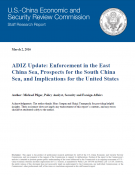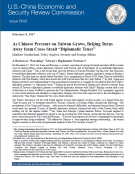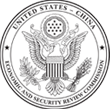Research
Research

The U.S.-China Economic and Security Review Commission 2016 Public Hearing schedule.
Research

This report assesses the extent to which China has enforced its air defense identification zone (ADIZ) in the East China Sea, and considers the potential conditions and implications of a Chinese ADIZ in the South China Sea.
Research

The report examines the Chinese government’s actions to promote the use of its currency, the renminbi (RMB), in the global monetary system as a payment currency for cross-border trade and financial transactions, a vehicle currency for foreign trade and international capital transactions, and a reserve currency. The report analyzes the potential effects of the rising prominence of the RMB on the financial clout of the United States and the U.S. dollar’s role in denominating international trade transactions and settling cross-border financial transactions.
Research

On January 16, 2016, Taiwan held its presidential and parliamentary elections. Focusing on economic and local issues in the campaign, the Democratic Progressive Party (DPP) presidential candidate Tsai Ing-wen and her running mate Chen Chien-jen won the election with over 56 percent of the vote, while the traditionally pro-independence DPP captured an outright majority in the Legislative Yuan (LY) for the first time in Taiwan’s history, winning 68 of 113 seats. With the DPP’s victories in the presidential and LY elections, the party can pursue its economic and cross-Strait goals. This issue brief analyzes the results of Taiwan’s elections and discusses the implications of the elections for cross-Strait relations and the United States.
